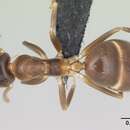tr
kırıntılardaki isimler


Taxonomic history
See also: Bolton, 2007b PDF: 55.NOTE
Type - compared material has been supplied by Brian L. Fisher (CASC) and excellent photographs of the syntypes are available on his Malagasy ant web - site.
WORKER. Measurements: TL 2.7 - 4.0, HL 0.66 - 0.84, HW 0.60 - 0.79, SL 0.68 - 0.87, PW 0.38 - 0.52, WL 0.84 - 1.20 (25 measured). Indices: CI 91 - 95. SI 108 - 116, OI 23 - 26, EPI 72 - 82, DTI 132 - 154.
Frontal carina with 2 setae: first above the torulus, second at the level of the anterior margin of the eye. Dorsum of head posterior to this with a single pair of setae, in profile located about half way between level of posterior margin of eye and posterior margin of the head, not at the posterior margin. Anterior clypeal margin with a small median concavity; posterior margin of head shallowly concave in full-face view and the sides convex. Eyes located in front of midlength, EPI <90; outer margin of eye fails to break the outline of the side. Number of setal pairs on mesosoma: pronotum 1; mesonotum 0; propodeal dorsum 0; lateral margins of propodeal declivity usually 1, rarely 2, the setae arising directly behind or slightly below the level of the spiracle; without setae that arise from the margin above the level of the spiracle. With mesosoma in profile the mesonotal outline forms a long shallow slope, without a distinct step or angle in the outline that defines conspicuous dorsal and declivitous faces. Dorsum of propodeum relatively long in profile and meeting the declivity in a blunt angle; straight - line length of dorsum is at least equal to depth of declivity to spiracle. The spiracle itself is anterior to the margin of the declivity, not at the margin. In dorsal view the metathoracic spiracles do not abut the metanotal groove. Gastral tergites 1 - 4 each with setae present; maximum length of setae on first gastral tergite is usually slightly less than the maximum diameter of the eye but sometimes the two are subequal. Head, mesosoma, petiole and gaster dark brown to blackish brown. Coxae, femora and tibiae the same colour as the mesosoma or slightly lighter. Tarsi of middle and hind legs dull brownish yellow to dull yellow, paler than the tibiae.
Superficially mayri resembles a larger and more slender version of difficilis , but is easily distinguished by the structure of the propodeum. In difficilis the length of the propodeal dorsum in profile is always much less than the depth of the declivity to the spiracle and marginal setae arise from the declivity above the level of the spiracle. By contrast, in mayri the length of the propodeal dorsum in profile is at least equal to the depth of the declivity to the spiracle, and may be more; marginal setae arise from the declivity directly behind the spiracle or even slightly below it, but none arise above it. Workers of mayri tend to be larger than those of difficilis and have longer scapes and a more elongated, narrow mesosoma, compare the above dimensions of mayri with those of difficilis : HL 0.57 - 0.65, HW 0.52 - 0.61, SI 95 - 105, DTI 127 - 135. Finally, the metathoracic spiracles in difficilis abut, or very nearly abut, the metanotal groove in dorsal view, whereas in mayri the spiracles are usually noticeably anterior to the metanotal groove. See also the notes under difficilis .
The setae on the propodeal declivity seem particularly prone to loss by abrasion in this species. Sometimes their pits can be seen, particularly in specimens where full adult colour has not been attained, but in fully coloured specimens the pits are usually not apparent.
T. mayri nests terrestrially in and under rotten wood. It forages through the leaf litter and in fallen twigs and timber and has been collected from pitfall traps, but it also forages extensively on low vegetation and may nest in dead twigs above the ground. Worker - queen intercastes are present, as well as alate queens.
MATERIAL EXAMINED
Madagascar: Prov. Antsiranana, R.S. Manongarivo (B.L. Fisher); R.S. Manongarivo, SW Atanambao (B.L. Fisher); Antsiranana, Ampasindava, Ambilanivy (Fisher et al); Ampasindava, S. Ambahila (Fisher et al); Antsiranana, P.N. Marojejy (Fisher et al.); P.N. Marojejy, NNE Andapa (Fisher et al); Marojejy (Quinter & Nguyen); Marojejy, NW Manantenina (E.L. Quinter); Antsiranana, For. Binara (Fisher et al); Antsiranana, Sakalava Beach (R. Harin'Hala); Antsiranana, For. Antsahabe (Fisher et al); Antsiranana, P.N. Montagne d'Ambre (Schlinger et al); Prov. Fianarantsoa, R.S. Ivohibe (B.L. Fisher); Fianarantsoa, P.N. Ranomafana (R. Harin'Hala); P.N. Ranomafana (Rin'Ha & Irwin); P.N. Ranomafana (J.S. Schwiekert); P.N. Ranomafana, Vatoharanana (Fisher et al); 3 km. W Ranomafana, nr Ifanadiana (P.S. Ward); Ranomafana Nat. Pk, Talatakely (Lee & Ribardo); S Ambalavao (B.L. Fisher); Fianarantsoa, W Andrambovato (Fisher et al); Prov. Toamasina, Mont Anjanaharibe, Ambinanitelo (Fisher et al); Toamasina, Mont. Akirindro (Fisher et al); Toamasina, P.N. Mantadia (H.J. Ratsirarson); Toamasina, Mahavelona (Foulpointe) (A. Pauly); Toamasina, For. Ambatovy (B.L. Fisher); Toamasina, 25 km. W Morarano - Chrome (A. Pauly); Prov. Toliara, P.N. Andohahela, ESE Mahamavo (Fisher et al); 9.2 km. WSW Befingotra, Res. Anjanaharibe - Sud (B.L. Fisher); 6.9 km. NE Ambanizana (B.L. Fisher); 70.7 km. NNE Tolanaro, Mah�rmano Mt. (K.C. Embertson); 9.2 km. N Tolanaro, Ilapiry Mt. (K.C. Embertson); 5.3 km. SSE Ambanizana, Andranobe (B.L. Fisher).
Technomyrmex mayri is een mierensoort uit de onderfamilie van de Dolichoderinae.[1][2] De wetenschappelijke naam van de soort is voor het eerst geldig gepubliceerd in 1891 door Forel.
Bronnen, noten en/of referentiesTechnomyrmex mayri é uma espécie de formiga do gênero Technomyrmex.[1]
Technomyrmex mayri é uma espécie de formiga do gênero Technomyrmex.